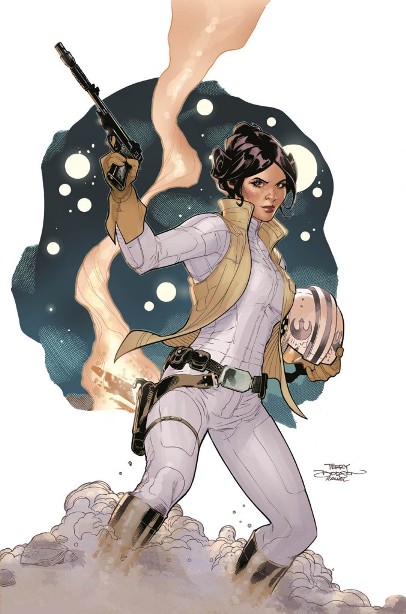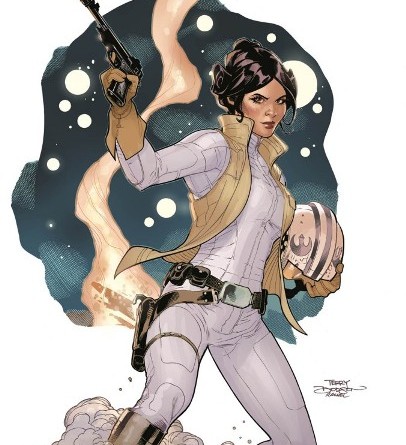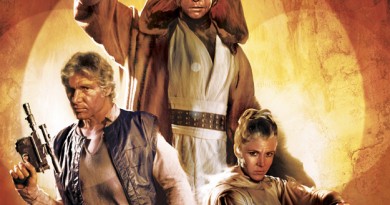Legions of Leia Fans
Legion of Leia has been profiling women in geek culture over the past months. Last week the site featured former DC and Disney Publishing Worldwide comics editor Janelle Asselin. When asked about franchises and characters in science fiction and fantasy that first grabbed her attention, she answered:
Star Wars and Leia, absolutely. I have a brother who’s 11 years older than me, so he saw all the Star Wars movies in the theater, and by the time I came around, he wanted to indoctrinate me into a love of Star Wars. I literally don’t remember the first time I saw any of the Star Wars movies – they were just always there! My brother would sit me down to watch the movies and lecture me about the importance of the special effects they used and why the movies were amazing. But it was my own love of sassy princesses that made me like Leia so much. She was tough and smart and she wasn’t second fiddle to anyone. I didn’t realize until I got older how amazing that was. She has power and agency and when she DOESN’T have agency she chokes someone to death until she’s free. I think the best thing about Leia is that she’s not strong because she’s not feminine. She’s strong AND feminine. Most of her power comes from diplomacy but she’s not afraid to fight and show her whiny twin brother how it’s done. She is the best.
Asselin recommends Saga, Captain Marvel, and Ms. Marvel to Legion of Leia readers. Saga and Ms. Marvel were mentioned in NPR’s article “Lessons Behind the Counter at a Comic Book Store.”
The importance of female readership — particularly its economic importance — is something Esther has experienced as a store manager. Fantom has a list of weekly subscribers, and a quarter of them are women. And it’s the comics with female characters that are making money. According to their most recent data, Fantom’s best-selling superhero comic is Ms. Marvel, starring a teenage Pakistani-American from New Jersey, the first Muslim character to get her own series. The best-selling title overall is Saga, another series in which many of the main characters are female. And both Ms. Marvel and Saga have female creators — G. Willow Wilson writes Kamala Khan’s adventures as Ms. Marvel, and Fiona Staples is behind Saga’s gorgeous art.
Esther and Zephi Friel, a 25-year-old employee at Fantom, both insist that it’s not just women who buy titles like Ms. Marvel and Saga. “If it’s a great story, everybody reads it,” they tell me.
Both titles have received a lot of buzz recently. The Daily Dot discussed the significance of the sixth printing of Ms. Marvel #1. At the Eisner Awards announced at San Diego Comic-Con, Saga won Best Continuing Series, Best Writer, and Best Painter/Multimedia Artist (interior art). io9 recapped the Saga panel. Of his co-creator Fiona Staples, Brian K. Vaughan says:
[H]is job increasingly consists of getting out of Staples way. He credits her with the multiracial look of the people populating their universe. He confesses that he, unfortunately, tends to view white people as the default when creating characters. When he and Staples were discussing Alana’s character design he told Staples that he didn’t want Alana to be a redhead because there is a glut of redheads in science fiction. “Well,” she told him, “she doesn’t have to be white either.”
The success of Saga – precisely because it offers something different to comics readers – speaks right to the heart of efforts like Legion of Leia and Asselin with her Hire This Woman series at Comics Alliance. Women bring a different perspective, and through collaboration of diverse creative teams the bar is raised on storytelling.
Like Asselin, the creators of Saga have been influenced by Star Wars, and through their story they are challenging at least one long standing trope from the franchise:
Saga may have a bit of Star Wars in its science fiction/fantasy mashup DNA, but one character was inspired by a Star Wars image that always bothered Vaughan: Princess Leia in that slave outfit. “That’s that character at her least sexy,” Vaughan said to thunderous applause. “There are slave girls in the world and they don’t look like Princess Leia in a bikini.” Vaughan and Staples created the character Slave Girl (now Sophie) in part because they wanted to show the horrific side effects of war. “I’m glad that Slave Girl gets to be Sophie,” he said.
In SF Signal’s July 28th link roundup (via @PattyBones2), quite a few people had things to say about Slave Leia:
As news spreads that Disney will be adding Leia themed toys to its merchandise, more and commentators are noting how often Leia is shown as a slave in kidworld. Considering the The Terrible Unspoken Implications Of Star Wars’ Slave Leia is this on-going criticism Slut-shaming Princess Leia or protecting childhood from adult sexuality? The debate is not a new one. Many fans have come out In Defense of Slave Leia, and almost as many have come out In Response to In Defense of Slave Leia. The controversy is part of why Star Wars is so Terrifying for Women. BtchFlcks thoughtfully posed the question earlier of whether Princess Leia is a Feminist Icon or Sexist Trope? Of course, it isn’t just women discussing the controversy, Having previously written an article titled “Don’t Dress as Slave Leia” and then, a rather more nuanced rehash in which he explored why telling people not to dress as Slave Leia is not itself free from problems, Ryan (of Mad Art Lab) has decided that, actually, he’s going to dress as Slave Leia this con season; or, rather, Slave Leo. Carrie Fisher discussed the costume in a 1983 interview with Rolling Stone. (Via)
The issue of Slave Leia is complicated. As a character Slave Leia doesn’t lose her agency, but there is no denying based on Carrie Fisher’s thoughts on the matter that the storytelling choice was made to appeal to a boy’s fantasy and to soften her commanding character. Many cosplayers take power from the costume, in which Leia choked her captor to death and freed herself. Yet there is no denying that Lucasfilm has relied heavily on the image of Leia in a slave costume, so much so that many women perceive the role as blatant objectification in service of the bottom line. Often the answer to that criticism is that the visual is “iconic.” Of course, Lucasfilm has the power to make any image iconic.
With that said, here’s to hoping that new comics, like the upcoming Marvel five-issue mini-series Star Wars: Princess Leia, with a first-issue cover featuring Leia in an X-wing flightsuit, reshape the notion of what is sexy and sells.

For updates on all things FANgirl follow @FANgirlcantina on Twitter or like FANgirl Zone on Facebook. At times she tries the Tumblr.
- Hyperspace Theories: Bad Luck Ghorman - June 2, 2025
- Hyperspace Theories: One Year Later as ANDOR Kicks Off Season Two - May 15, 2025
- REVIEW: Tales of the Underworld - May 4, 2025












Pingback:Put More Of This In My Star Wars Read-Along: SAGA « FANgirl Blog